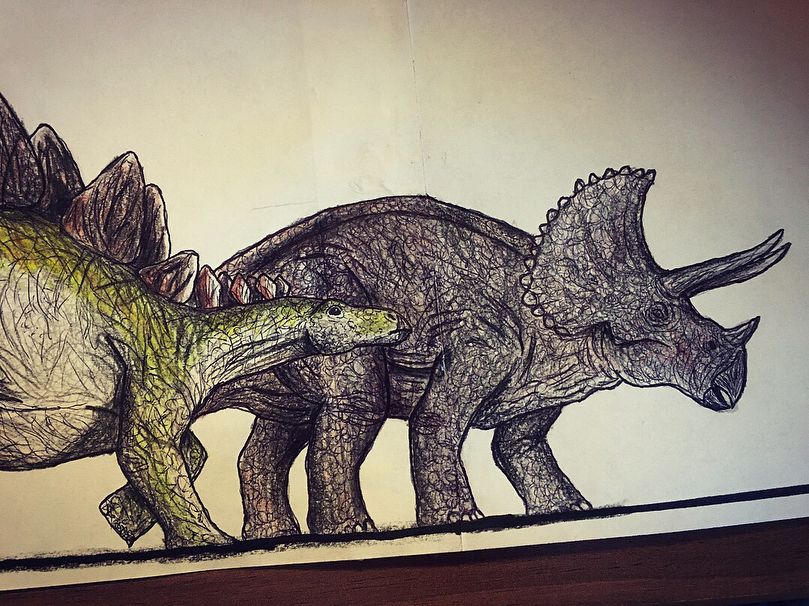Dinosaurs are among the most fascinating creatures in Earth’s history, captivating scientists and enthusiasts alike with their diversity, adaptability, and unique evolutionary traits. Two dinosaurs often spotlighted for their distinct features are the Brachiosaurus and Stegosaurus.
Despite both being herbivorous dinosaurs from the Late Jurassic period, they were strikingly different in appearance, anatomy, and lifestyle. In this article, we’ll explore the key differences between Brachiosaurus and Stegosaurus, providing a clearer understanding of what set these giants apart.
Table of Contents
Toggle1. Size and Build
- Brachiosaurus: Known for its immense size, the Brachiosaurus was one of the largest dinosaurs, reaching lengths of up to 85 feet and weights exceeding 30-40 tons. Its long neck and tall forelimbs gave it a distinctive “giraffe-like” build, with its head towering high above the ground. This unique structure allowed Brachiosaurus to reach vegetation that was inaccessible to most other herbivores.
- Stegosaurus: While still large by today’s standards, Stegosaurus was significantly smaller than Brachiosaurus. It measured around 25-30 feet in length and weighed approximately 5-7 tons. Its body was stockier and lower to the ground, making it a more heavily built, armored dinosaur, better suited for close-to-ground browsing.
2. Neck and Head Structure
- Brachiosaurus: The long neck of Brachiosaurus is one of its most distinctive features. Unlike many other dinosaurs with long necks, Brachiosaurus had longer front limbs than back limbs, giving it an upward incline, which positioned its head far above most vegetation. Its head was relatively small in comparison to its body, with nostrils located on top of its skull, a unique trait that may have aided in cooling or breathing at higher altitudes.
- Stegosaurus: In contrast, Stegosaurus had a short neck and a relatively small, low-slung head, adapted for feeding on low-lying plants and shrubs. Its neck was more muscular and compact, designed for strength rather than reach, allowing it to graze close to the ground.
3. Diet and Feeding Habits
- Brachiosaurus: As a high-browser, Brachiosaurus primarily fed on tall vegetation, such as conifers, ginkgoes, and other tall, gymnosperm trees. Its long neck allowed it to reach the upper canopy, where it could access food sources that were unreachable to shorter herbivores, giving it an ecological advantage.
- Stegosaurus: Stegosaurus, on the other hand, was a ground feeder. It likely fed on low-lying ferns, cycads, and other shrubs. Its teeth were better suited for clipping vegetation rather than chewing it, suggesting that Stegosaurus may have swallowed food whole, relying on gastroliths (stomach stones) to help break down plant material.
4. Defense Mechanisms
- Brachiosaurus: With its colossal size and towering height, Brachiosaurus likely relied on its sheer size as its primary defense against predators. Few Jurassic predators would have been capable of challenging a fully-grown Brachiosaurus. Its height also provided an advantage by keeping a lookout for potential threats from afar.
- Stegosaurus: In contrast, Stegosaurus was equipped with two distinct defensive features: its bony back plates and its spiked tail, known as a “thagomizer.” The plates along its back likely served multiple functions, including display, thermoregulation, and deterrence. Meanwhile, the spiked tail could deliver powerful blows to predators, making Stegosaurus a difficult target for even the fiercest carnivores like Allosaurus.
5. Posture and Mobility
- Brachiosaurus: The Brachiosaurus’s body structure and limb proportions suggest that it was a relatively slow-moving dinosaur that spent most of its time grazing on high vegetation. Its size limited its agility, but it likely did not need to be very mobile due to its access to vast amounts of food at varying heights.
- Stegosaurus: While not particularly fast, Stegosaurus was more agile than Brachiosaurus due to its smaller size and lower center of gravity. It likely moved in a slower, lumbering gait but could maneuver more easily, especially with the defensive capability of its tail, which would require some dexterity to wield effectively against predators.
6. Era and Geographic Range
- Brachiosaurus and Stegosaurus both lived during the Late Jurassic period, approximately 155 to 150 million years ago. Fossils of Brachiosaurus have been primarily found in North America and parts of Africa, whereas Stegosaurus fossils have been mainly discovered in North America and Europe. These overlapping ranges suggest they may have shared similar ecosystems, though they occupied different ecological niches due to their unique dietary and physical adaptations.
7. Fossil Discoveries and Interpretations
- Brachiosaurus: Brachiosaurus fossils are relatively rare, and much of what we know about this dinosaur comes from partial skeletons and comparative analysis with similar sauropods. The most complete Brachiosaurus skeleton was discovered in Colorado in the early 20th century, providing significant insight into its anatomy.
- Stegosaurus: Fossils of Stegosaurus are more common, making it one of the better-studied dinosaurs. Its unusual morphology has intrigued paleontologists, leading to various theories about the function of its back plates and tail spikes. The first Stegosaurus fossil was discovered in Colorado in 1877, and ongoing discoveries continue to refine our understanding of this iconic dinosaur.
Conclusion
While Brachiosaurus and Stegosaurus both roamed the Earth during the Late Jurassic period and shared some broad similarities as herbivorous dinosaurs, their differences are striking. Brachiosaurus was a towering, high-browsing giant adapted for feeding on tall trees, while Stegosaurus was a heavily armored, ground-level grazer with distinctive defense features. Their unique adaptations reveal the incredible diversity of dinosaur evolution, showcasing how different forms, structures, and lifestyles allowed them to thrive alongside one another in prehistoric ecosystems. For more Stegosaurus information check the dinorepeat.

